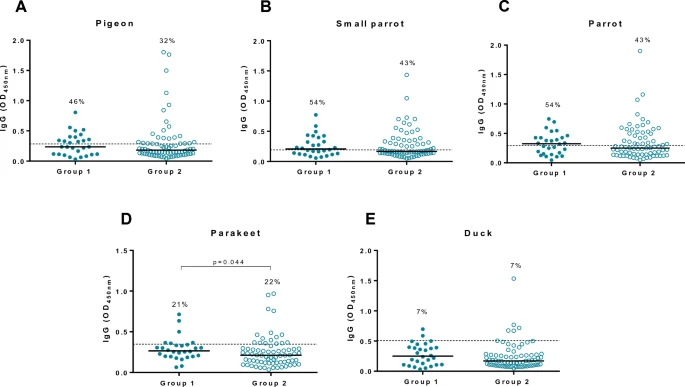Sánchez-Díez, S., Muñoz, X., Montalvo, T. et al. Allergy Asthma Clin Immunol 19, 96 (2023). https://doi.org/10.1186/s13223-023-00852-w
Abstract
Introduction
Hypersensitivity pneumonitis (HP) is usually caused by the inhalation of avian and fungal proteins. The present study assesses a cohort of Urban Pest Surveillance and Control Service (UPSCS) workers with high exposure to avian and fungal antigens, in order to identify their degree of sensitization and the potential risk of developing HP.
Methods
Workers were divided according to their work activity into Nest pruners (Group 1) and Others (Group 2). All individuals underwent a medical interview, pulmonary function tests and the determination of specific IgG antibodies. Antigenic proteins of pigeon sera were analysed using two-dimensional immunoblotting. Proteins of interest were sequenced by liquid-chromatography–mass spectrometry (LC–MS).
Results
101 workers were recruited (76 men, average age: 42 yrs); (Group 1 = 41, Group 2 = 60). Up to 30% of the study population exhibited increased levels of IgGs to pigeon, small parrot and parrot, and up to 60% showed high levels of Aspergillus and Penicillium IgGs. In Group 1, specific parakeet and Mucor IgGs were higher (p = 0.044 and 0.003 respectively) while DLCO/VA% were lower (p = 0.008) than in Group 2. Two-dimensional immunoblotting showed protein bands of 20–30 KDa recognized by HP patients but not by workers. LC–MS analysis identified Ig Lambda chain and Apolipoprotein A-I as candidate proteins for distinguishing HP patients from exposed workers.Conclusions
Two pigeon proteins were identified that may play a role in the development of pathological differences between HP patients and exposed workers. DLCO/VA may have a predictive value in the development of HP disease.


No comments:
Post a Comment